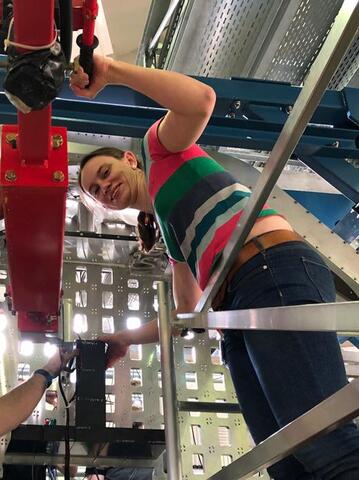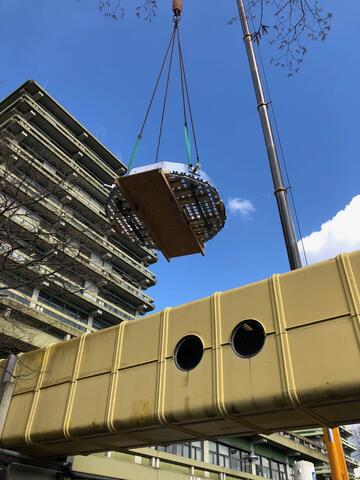Workshop „Physics Opportunities with Proton Beams at SIS100” was held in Wuppertal
PANDA meetings
04/03-08/03 2024 CM 24/1 in Münster
24/06-28/06 2024 CM 24/2 at GSI
25/06-26/06 2024 FEE/DAQ Workshop
04/11-06/11 2024 CM 24/3 at GSI
05/03-07/03 2025 WS at GSI
16/06-20/06 2025 CM 25 in Uppsala
Development of the Recoil Detector for the HESR Day-One Experiment and Commissioning at COSY by Measuring pp Elastic Scattering
Qiang Hu
TH-PHD-2015-009.pdf
(18.03 MB)
The PANDA experiment is one of the future experiments at FAIR, it will pursue a broad
physics program with high quality antiproton beam in the momentum region from 1.5 to
15 GeV/c. The goal of the PANDA luminosity detector is to determine the absolute in-
tegrated luminosity with precision of
∆L/L ≤ 3%. The antiproton-proton elastic scattering
differential parameters, σ tot , ρ and b are needed for the PANDA luminosity calibration
in order to achieve this high precision of absolute normalization. However, the existing
data of σ tot , ρ and b in the PANDA beam momentum range are not sufficient by precise
for the PANDA luminosity calibration.
The HESR Day-One experiment is dedicated to determine the differential param-
eters by measuring antiproton-proton elastic scattering in a large range of squared 4-
momentum transfer, |t|. The HESR Day-One experiment will measure the elastically
scattered antiprotons and recoil protons with the PANDA luminosity detector and a
recoil detector, respectively. One recoil detector consists of two silicon and two germa-
nium sensors by covering the polar angle range from θ = 71 ◦ to 91.5 ◦ . The silicon and
germanium detectors are single-sided strip structure. Both silicon detectors have the di-
mensions 76.8 mm × 50 mm × 1 mm. The two germanium detectors have the same ac-
tive area of 80.4 mm × 50 mm, but with thickness of 5 mm and 11 mm, respectively. The
silicon detectors will measure the recoil protons below 12 MeV, and the germanium de-
tector will measure the recoil protons up to 60 MeV.
A dedicated recoil detector for tests with proton beam at COSY has been built. After
assembly, the silicon and germanium detectors have been tested in the laboratory with
the radioactive source 244 Cm. The optimal operation temperature, 125 K, of the germa-
nium has been determined. The energy resolutions of the silicon and germanium detec-
tors at 125 K are better than 20 keV and 30 keV, respectively.
Energy calibration for the silicon and germanium detectors has been studied. The
uncertainty of ADC’s nonlinearity is about 0.31%. The silicon detectors have been
calibrated with several standard sources and the uncertainty of the energy calibration of
the silicon detectors has been estimated to be around 0.33%. The germanium detectors
have been calibrated with the radioactive sources 60 Co, 137 Cs and 244 Cm. Based on the
α particle’s energy deposited in the sensitive area of the germanium detectors, the dead-
layer thickness of the Ge #1 and Ge #2 sensors have been determined to be 0.72 μm
and 0.82 μm of equivalent silicon, respectively. The uncertainty of energy calibration of
the germanium detector is about 0.31%.
Simulation studies of proton-proton elastic scattering at 3.2 GeV/c has been per-
formed. The detector’s acceptance has been obtained. The differential counts as a func-
tion of |t| has been reconstructed with acceptance correction. The proton-proton elastic
scattering differential parameters σ tot , ρ and b have been determined by analyzing the
characteristic shape of the |t| distribution with optical theory and parameterized expres-
sions.
Due to the recoil particle and kinematics to be measured in pp→pp are the same
as that in pp →pp at a certain beam momentum, it is reasonable to learn about pp →pp
from pp→pp. Therefore, the recoil detector was installed at the ANKE cluster target sta-
tion at COSY and commissioned by measuring proton-proton elastic scattering in 2013.
Data were taken at beam momenta of 1.7, 2.5, 2.8 and 3.2 GeV/c. For 2.8 GeV/c and 3.2
GeV/c, the differential counts as a function of |t| distributions have been reconstructed
based on the centroid energy and elastic events in the identical strips. After analysing
the characteristic shape of the |t| distribution, the elastic scattering differential parame-
ters and integrated luminosity have been determined. The uncertainty of σ tot and b were
better than 1% and of ρ was about 2%. The absolute integrated luminosity within preci-
sion of ∆L/L ≤ 3% was achieved. Comparing the measured σ tot and ρ with the predicted
values based on existing data, the differences between our results and the predicted
values are less than 1.5%, but the measured b values are about 20% greater than the
predicted ones. The differential cross section
obtained. The dσ/dt at 2.8 GeV/c and 3.2 GeV/c have been
distribution of our results in the range of |t| ∈ [0.02, 0.095] (GeV/c) 2
are in good consistent with the existing data at 3.0 GeV/c. These results demonstrate
that the HESR Day-One experiment is feasible and the data analysis method is reliable.
physics program with high quality antiproton beam in the momentum region from 1.5 to
15 GeV/c. The goal of the PANDA luminosity detector is to determine the absolute in-
tegrated luminosity with precision of
∆L/L ≤ 3%. The antiproton-proton elastic scattering
differential parameters, σ tot , ρ and b are needed for the PANDA luminosity calibration
in order to achieve this high precision of absolute normalization. However, the existing
data of σ tot , ρ and b in the PANDA beam momentum range are not sufficient by precise
for the PANDA luminosity calibration.
The HESR Day-One experiment is dedicated to determine the differential param-
eters by measuring antiproton-proton elastic scattering in a large range of squared 4-
momentum transfer, |t|. The HESR Day-One experiment will measure the elastically
scattered antiprotons and recoil protons with the PANDA luminosity detector and a
recoil detector, respectively. One recoil detector consists of two silicon and two germa-
nium sensors by covering the polar angle range from θ = 71 ◦ to 91.5 ◦ . The silicon and
germanium detectors are single-sided strip structure. Both silicon detectors have the di-
mensions 76.8 mm × 50 mm × 1 mm. The two germanium detectors have the same ac-
tive area of 80.4 mm × 50 mm, but with thickness of 5 mm and 11 mm, respectively. The
silicon detectors will measure the recoil protons below 12 MeV, and the germanium de-
tector will measure the recoil protons up to 60 MeV.
A dedicated recoil detector for tests with proton beam at COSY has been built. After
assembly, the silicon and germanium detectors have been tested in the laboratory with
the radioactive source 244 Cm. The optimal operation temperature, 125 K, of the germa-
nium has been determined. The energy resolutions of the silicon and germanium detec-
tors at 125 K are better than 20 keV and 30 keV, respectively.
Energy calibration for the silicon and germanium detectors has been studied. The
uncertainty of ADC’s nonlinearity is about 0.31%. The silicon detectors have been
calibrated with several standard sources and the uncertainty of the energy calibration of
the silicon detectors has been estimated to be around 0.33%. The germanium detectors
have been calibrated with the radioactive sources 60 Co, 137 Cs and 244 Cm. Based on the
α particle’s energy deposited in the sensitive area of the germanium detectors, the dead-
layer thickness of the Ge #1 and Ge #2 sensors have been determined to be 0.72 μm
and 0.82 μm of equivalent silicon, respectively. The uncertainty of energy calibration of
the germanium detector is about 0.31%.
Simulation studies of proton-proton elastic scattering at 3.2 GeV/c has been per-
formed. The detector’s acceptance has been obtained. The differential counts as a func-
tion of |t| has been reconstructed with acceptance correction. The proton-proton elastic
scattering differential parameters σ tot , ρ and b have been determined by analyzing the
characteristic shape of the |t| distribution with optical theory and parameterized expres-
sions.
Due to the recoil particle and kinematics to be measured in pp→pp are the same
as that in pp →pp at a certain beam momentum, it is reasonable to learn about pp →pp
from pp→pp. Therefore, the recoil detector was installed at the ANKE cluster target sta-
tion at COSY and commissioned by measuring proton-proton elastic scattering in 2013.
Data were taken at beam momenta of 1.7, 2.5, 2.8 and 3.2 GeV/c. For 2.8 GeV/c and 3.2
GeV/c, the differential counts as a function of |t| distributions have been reconstructed
based on the centroid energy and elastic events in the identical strips. After analysing
the characteristic shape of the |t| distribution, the elastic scattering differential parame-
ters and integrated luminosity have been determined. The uncertainty of σ tot and b were
better than 1% and of ρ was about 2%. The absolute integrated luminosity within preci-
sion of ∆L/L ≤ 3% was achieved. Comparing the measured σ tot and ρ with the predicted
values based on existing data, the differences between our results and the predicted
values are less than 1.5%, but the measured b values are about 20% greater than the
predicted ones. The differential cross section
obtained. The dσ/dt at 2.8 GeV/c and 3.2 GeV/c have been
distribution of our results in the range of |t| ∈ [0.02, 0.095] (GeV/c) 2
are in good consistent with the existing data at 3.0 GeV/c. These results demonstrate
that the HESR Day-One experiment is feasible and the data analysis method is reliable.





